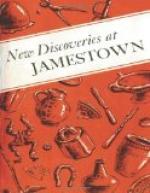There is also good evidence that some trade was carried on with Holland, Germany, Italy, Spain, Portugal, France, Mexico, and the West Indies. Many artifacts unearthed (especially pottery) were made in the countries mentioned. It is believed that certain commodities were acquired by direct trade with the country where made, in spite of the strict laws by which the Colonial Powers sought to monopolize the colonial trade for the benefit of the mother country.
Lead Bale Clips.—A series of decorated lead clips which relate to 17th-century trade have been found at several places on Jamestown Island. As their name implies, these lead clips, or seals, were attached to bales of English goods, usually woolen cloth, to attest that the goods were of an approved quality and length, and of a given amount. Each clip usually consisted of two discs connected by a narrow band, and when used for marking cloth the name or initials of the maker of the material was often incised on one of the discs. The clips, too, were often embossed with a decorative device such as a coat of arms, crest, crown, name or initials of a king, numerals, king’s head, royal arms, animal, or flower. Over a dozen of these small lead clips have been unearthed, and serve as reminders of a past day when majestic English merchantmen sailed to Jamestown laden with bales of goods from the mother country.
[Illustration: Lead bale clips used for sealing bales of woolen cloth and other goods. Once A clip had been attached to A bale it attested that the goods were of an approved quality and length or amount.]
[Illustration: This 1,300-pound iron piledriver used for driving piles in the building of small wharves was found at Jamestown.]
[Illustration: Building A wharf, about 1650. (Conjectural sketch by Sidney E. King.)]
Piers and Wharfs.—In order to accommodate such large sailing vessels, piers and wharfs had to be built at Jamestown. A 1,300-pound iron piledriver was found in the basement of a 17th-century building in 1955. It was probably used three centuries ago for driving piles in the James River during construction of a small wharf.
Worshipping
The Jamestown colonists were, for the most part, religious and God-fearing people. The majority were members of the Church of England. One of the first settlers, the Rev. Robert Hunt, was an ordained minister of that church. Whenever possible, services were held every morning and evening, and sermons delivered twice on Sundays.




